Want to learn how to play poker with friends but don’t know where to start? Poker nights bring people together and create lasting memories around a table of cards and chips. I’ll show you everything you need to host an amazing poker night, from picking the right game type to setting up the perfect space.
Ready to become the host of the most talked-about poker nights in your friend group? Let’s start with the basics.
Key Takeaways
A basic poker setup needs cards, chips, comfortable seating for 6–8 players, and good lighting – with Texas Hold’em being the most popular game choice for beginners.
Start with low stakes like $0.25/$0.50 blinds or $50 buy-ins to keep games friendly, and set clear house rules about betting limits, breaks, and player conduct before starting.
Learn the ten possible hand rankings from Royal Flush down to High Card, and focus on playing premium starting hands like AA, KK, QQ, AK suited, and JJ.
Online platforms like GGPoker offer private rooms where friends can play together remotely, with password protection and tracking features for wins and losses.
Watch for physical tells like breathing changes, chip handling, and posture shifts during play, but keep your own movements steady to avoid giving away information about your hand strength.
Table of Contents
Setting Up a Poker Game with Friends

Setting up a poker game needs some basic items: cards, chips, and a flat surface to play on. You’ll want to pick a cozy spot with good lighting and enough room for everyone to sit comfortably around the table, plus snacks and drinks within reach.
Choosing the right location
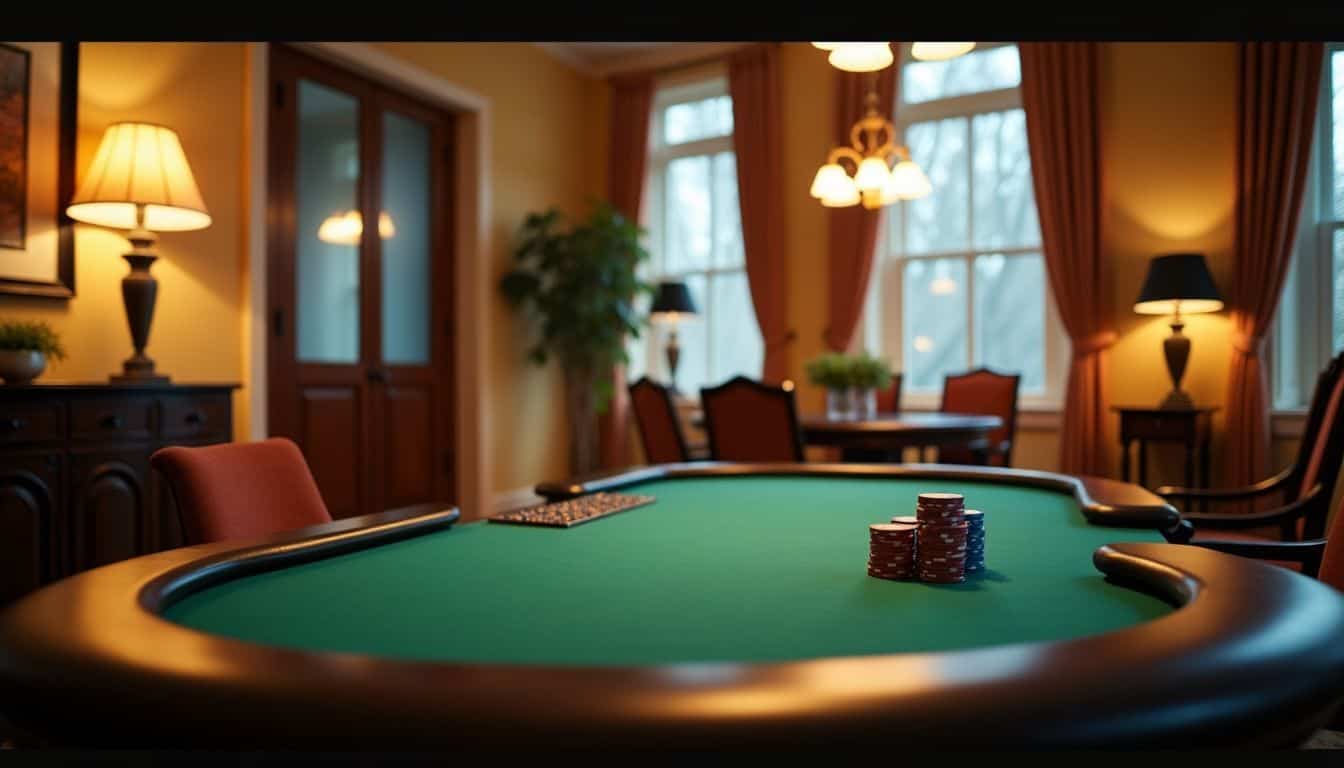
Your poker spot needs the right setup for a fun game night. Pick a room with enough table space for everyone to spread out and feel comfy – your dining room or living room works great! I’ve hosted dozens of poker games, and my dining room always hits the sweet spot.
The table gives players enough elbow room to check their poker hands without nosy neighbors peeking in.
The perfect poker room is like a sanctuary – quiet, spacious, and free from distractions. – Annie Duke
A good poker space keeps outside noise at bay. My friends and I love using my sitting room because it sits far from the kitchen buzz and street sounds. The room should fit 6–8 players easily around the table.
Good lighting helps players see their cards clearly, but avoid harsh overhead lights that create glare on the cards. Natural light through windows works best during day games, while soft lamps create the perfect evening poker vibe.
Gathering necessary supplies

A great poker night needs the right tools and supplies. Getting these items ready ahead of time will make your game night flow smoothly.
- A standard deck of playing cards – Pick up two decks so you can shuffle one while dealing with the other. Quality plastic-coated cards last longer and shuffle better.
- Poker chips (at least 500) – Start with basic clay or composite chips in different colors. Red chips typically equal 5, white equals 1, and blue equals 10.
- A solid table surface – A kitchen table works fine, but a felt-topped table makes cards easier to pick up. Add a table cover if needed.
- Comfortable seating – Grab enough chairs for everyone. Players might sit for several hours straight.
- Chip rack or organizer – Keep chips tidy and organized by value. This speeds up dealing and collecting bets.
- Timer or clock – Track blind levels and keep the game moving at a steady pace.
- Score pad and pen – Note buy-ins, rebuys, and final tallies for each player.
- Snacks and drinks – Stock up on chips, dips, nachos, and fajitas. Place drinks away from the playing surface.
- Cup holders – Protect your table from spills. Clip-on holders work great for most tables.
- Rule sheet – Print basic hand rankings and game rules for new players to reference.
- Small trash bin – Keep the playing area clean and tidy throughout the night.
- Good lighting – Make sure players can see their cards and chips clearly.
Deciding the game format

Poker games come in many shapes and sizes. Cash games offer the most flexibility, since players can join or leave at any time with their chips. The sit-and-go knockout format works great for a group of friends who want quick, exciting games without long waiting periods.
Players get eliminated one by one until there’s a winner, making the game more thrilling.
Texas Hold’em stands as the most popular poker variant for home games. Each player gets two private cards and shares five community cards on the table. The betting structure stays simple – players can either play with fixed limits or no-limit stakes.
For beginners, starting with small stakes helps everyone learn the game mechanics without risking too much money. The pot-limit format also keeps the game friendly by preventing massive bets that could strain friendships.
Establishing the Rules of the Game
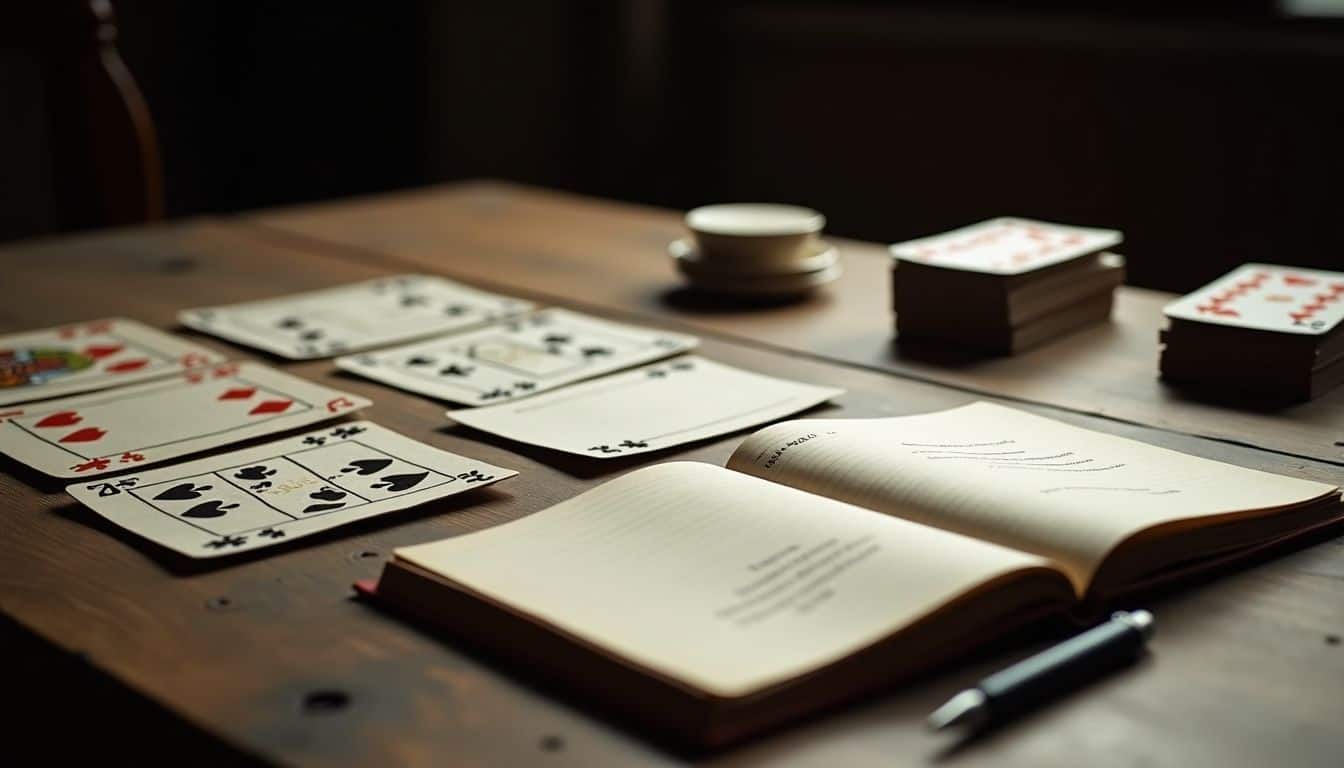
Clear rules make poker night run smooth as silk. Setting ground rules about betting limits and game type keeps everyone on the same page, just like agreeing on the rules before a game of tag.
Setting betting limits
Setting smart betting limits keeps poker fun and friendly. Start with low-stakes games like $0.25/$0.50 blinds or a $50 buy-in to learn the ropes without breaking the bank. Your group needs clear pot odds and ante rules before the cards hit the table.
Texas Hold’em works great for beginners since the betting structure stays simple.
Smart limits make happy players
Money shouldn’t ruin friendships over poker night. Skip the cash completely if you want – play for bragging rights or small prizes instead. The big blind and pot size matter less than having fun with your crew.
Set firm betting caps that everyone agrees to follow. This stops anyone from going overboard or feeling pressure to bet more than they can afford.
Determining the game structure (e.g., Texas Hold’em, Omaha)
After setting your betting limits, picking the right poker game style matters most. Texas Hold’em stands out as the top choice for new players. The rules flow smoothly, and you’ll grasp the basics in no time.
Each player gets two private cards and shares five community cards on the table. I started with Hold’em at my first home game, and it made learning poker feel like a breeze.
Omaha offers another fun option if your group wants to mix things up. Players receive four private cards instead of two, but must use exactly two of them with three community cards to make their hand.
The game creates bigger pots and more action than Hold’em. My poker nights often feature both games to keep everyone engaged. The key is to stick with one game type until your group feels comfortable before trying something new.
Your friends will thank you for keeping it simple and enjoyable.
Clarifying house rules
Once you’ve picked Texas Hold’em or Omaha as your game style, clear house rules will keep your poker night drama-free. Your group needs solid ground rules about bathroom breaks, phone use, and time limits for making decisions.
Smart players set rules about minimum buy-ins and maximum raises to keep the game fair and fun.
House rules should cover the nitty-gritty details that poker tournaments often miss. Set clear guidelines about food at the table, smoking breaks, and what happens if someone needs to leave early.
These basic rules stop arguments before they start and keep the focus on playing poker. Your friends will thank you for making these choices upfront.
Learning the Basics of Poker

Poker basics start with learning hand rankings, from the mighty Royal Flush down to a simple High Card, and you’ll love discovering how these combinations create exciting moments at the table – ready to learn more about mastering the game?
Understanding hand rankings
Hand rankings form the backbone of Texas hold’em poker. A royal flush sits at the top of the pile, followed by a straight flush, four of a kind, and full house. I learned this the hard way during my first game night – thinking my flush beat my friend’s full house! The 52-card deck creates ten possible hand combinations, with a single high card being the lowest possible hand.
Know your hand rankings like the back of your hand – it’s your poker survival guide! – Chris Moorman
Getting these rankings down pat takes practice, but here’s a neat trick: picture them as steps on a ladder, with each hand getting stronger as you climb up. Your next step in mastering poker strategy involves knowing which starting hands give you the best shot at winning.
Let’s explore those winning combinations next.
Knowing starting hands
Starting hands make or break your poker game. The best poker players know there are 169 possible hand combinations in Texas hold’em poker. Your goal? Focus on premium hands like AA, KK, QQ, AK (suited), and JJ.
These powerhouse combinations give you the best shot at winning big pots. Smart players fold weak hands early to save their chips for stronger opportunities.
Playing strong starting hands puts you ahead of most casual players at the table. Think of your starting hand as your foundation – you need solid ground to build a winning strategy.
Many beginners lose money by playing too many weak hands out of boredom or hope. Stay patient and stick to premium hands, especially in early positions. Your poker bankroll will thank you later.
The math backs this up – premium hands win more often and help you make better decisions throughout each hand.
Learning basic betting terms
Basic betting terms in poker feel like learning a new language at first. I picked up these terms during my first home game, and they’re simpler than they sound. You’ll need to know five key moves in Texas hold’em poker: fold means giving up your hand, check means passing the action without betting, bet means putting chips in the pot, call means matching someone’s bet, and raise means increasing the bet amount.
Your poker game will flow better once you master these basic actions. Think of folding as hitting the escape button – you’re out of the hand but save your chips. Checking works like passing the ball in basketball – you stay in without risking chips.
Betting and raising are your power moves, while calling keeps you in the game by matching others’ bets. These actions form the building blocks of no-limit hold’em strategy, just like learning to walk before you run.
Creating a Friendly Atmosphere

Playing poker with friends should feel like a fun party, not a high-stakes casino showdown. A relaxed game night creates perfect moments for sharing laughs and making memories, even when someone hits a lucky straight on the river.
Encouraging respectful behavior
Poker night shines brightest with good manners at the table. Treat each hand as a fun social activity, not a fierce battle for glory. Keep your cool during tough losses, and smile through bad beats.
Your friends will enjoy the game more if you stay positive and respectful.
A true poker player shows grace in victory and dignity in defeat.
Good sportsmanship makes Texas hold’em more fun for everyone. Congratulate others on their winning hands, and avoid trash talk that might hurt feelings. Simple acts like thanking the dealer and staying calm during big pots create a friendly vibe.
Small courtesies go far in making your poker night something friends look forward to each week.
Setting expectations for a casual game
A casual game night needs clear ground rules from the start. Tell your friends to keep the stakes low – maybe $5 or $10 buy-ins for Texas hold’em poker. This keeps the game fun and stops anyone from losing too much cash.
Make it clear that trash talk stays friendly, and everyone should focus on having a good time rather than winning big.
Your poker table should feel like a fun hangout spot, not a high-stakes casino game. Bring snacks and drinks to share, and take breaks between hands to chat and laugh. Some players might need help learning the rules or basic strategy – that’s totally fine! Experienced players should help newbies understand pot-limit Omaha or other game variations without making them feel silly.
The goal is creating memories with friends, not becoming the next world series of poker champion.
Balancing competition with fun
Poker nights should mix friendly vibes with healthy competition. You’ll want to keep the game exciting without making anyone feel bad about losing. Set small betting limits that won’t hurt anyone’s wallet, and take breaks to chat and share snacks.
This creates a perfect balance between serious play and social fun at your Texas hold’em table.
Your poker group needs clear ground rules to stay fun and competitive. Make jokes, celebrate good hands, and keep the trash talk light-hearted. Some players might focus hard on probability and game theory, while others just want to enjoy the social aspect.
That’s okay! The goal is to make everyone feel welcome while still playing a good game of hold’em. Mix up the games between serious rounds and more casual hands to keep the energy flowing.
Playing Poker with Friends Online

Playing poker online with friends brings the same thrill as in-person games, minus the need to clean up afterward. You can grab your phone or laptop, join a private poker room on GGPoker, and start dealing virtual cards with your buddies through WhatsApp calls.
Choosing a reliable online platform
GGPoker stands out as a top pick for online poker games with friends. This platform offers private poker rooms where you can set up games just for your group. The built-in tracking system helps you keep tabs on wins and losses, making it easy to settle up after each game.
Many poker platforms exist, but safety comes first. Pick a site with strong security features and good reviews from other players. Look for platforms that let you create password-protected tables and offer clear rules about fair play.
Your friends can join through simple invite links, making the setup quick and stress-free.
Setting up private poker rooms
Private poker rooms offer a safe space to play cards with your closest friends. You’ll love the Home Games feature on popular poker sites, where you can set up your own club with a special name and code.
Your friends need this code to join your private games, making it feel like an exclusive club just for your group.
Setting up your private room takes only a few clicks. Pick a club name that speaks to your group’s personality – maybe something funny or meaningful to your circle. Share the code with your friends through text or social media.
The best part? You can host both cash games and tournaments in your virtual poker room. This gives you the freedom to mix up game styles and keep things fresh for your poker squad.
Inviting friends to join
Getting your friends to join an online poker game is super easy. Send them a quick text with your poker room link, and they’ll jump right in. Most online poker platforms like pokernews.com let you create private tables just for your group.
You can even set up a quick game through your Facebook account.
Make the invite process fun and casual. Text your pals a funny poker gif or share a cool texas holdem poker strategy tip to get them excited. Pick a time that works for everyone, and keep the group small at first – maybe 4-6 players.
Your friends can join from their iPhone, iPad, or computer, making it super flexible. The best part? You can practice poker terms and share betting tips while playing together.
Watching for Friendly Tells
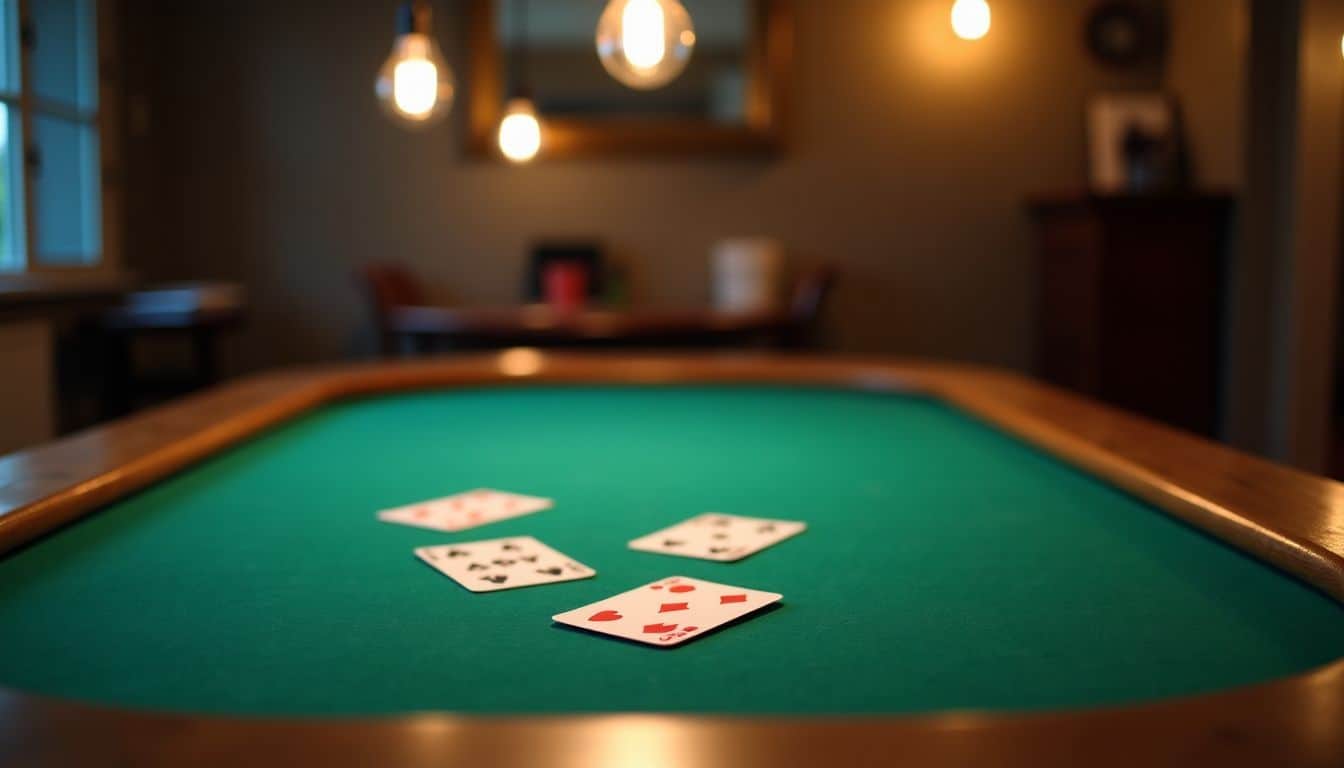
Your poker buddies might scratch their ears, tap their fingers, or bite their lips when they’re bluffing – these small actions can give you the upper hand in texas hold’em poker, and we’ll show you how to spot them in our next section.
Recognizing common tells
Players give away their hand strength through body language at the poker table. I noticed during texas hold’em games that strong eye contact often signals a weaker hand. My friends tend to stare more intensely when they’re bluffing or unsure.
Watch for sudden changes in posture too. A player who sits up straighter usually feels confident about their cards.
Small movements can reveal big secrets in poker. A player’s breathing pattern, chip handling, or even the way they place their bet can expose their hand strength. These physical tells become more obvious in home games where players feel relaxed among friends.
Learning to spot these signs takes practice, but mastering them helps you make better decisions at the table. Now let’s explore how to use these tells to your advantage in the next section.
Using tells strategically
Poker tells can become your secret weapon at the table. Your friends might go quiet during a texas hold’em hand – this often signals they’ve got strong cards. Pay close attention to how they stack their chips too.
Aggressive chip placement usually means they’re bluffing or holding weak cards. These small clues help you make better decisions during crucial moments in the game.
Smart players mix up their own tells to throw others off track. Try placing your chips differently each time, regardless of your hand strength. Keep your movements steady and your face neutral while playing.
This makes it harder for friends to spot patterns in your behavior. Your next challenge lies in mastering the proper etiquette at the poker table….
Avoiding giving away your own tells
Now that you know how to spot tells in others, you must guard your own poker face. Your body language speaks volumes at the texas hold’em table. Keep your movements steady and your expressions neutral during each hand.
Stay still while looking at your cards, and place your bets with the same motion every time.
Your playing style needs to stay consistent too. Mix up your actions between hands to avoid patterns. Don’t tap your fingers when you have a strong hand or fidget when bluffing. Place your chips in neat stacks and maintain the same betting rhythm.
A steady demeanor at the table keeps other players guessing and gives you a better shot at winning those big blinds.
Etiquette of Playing Poker with Friends
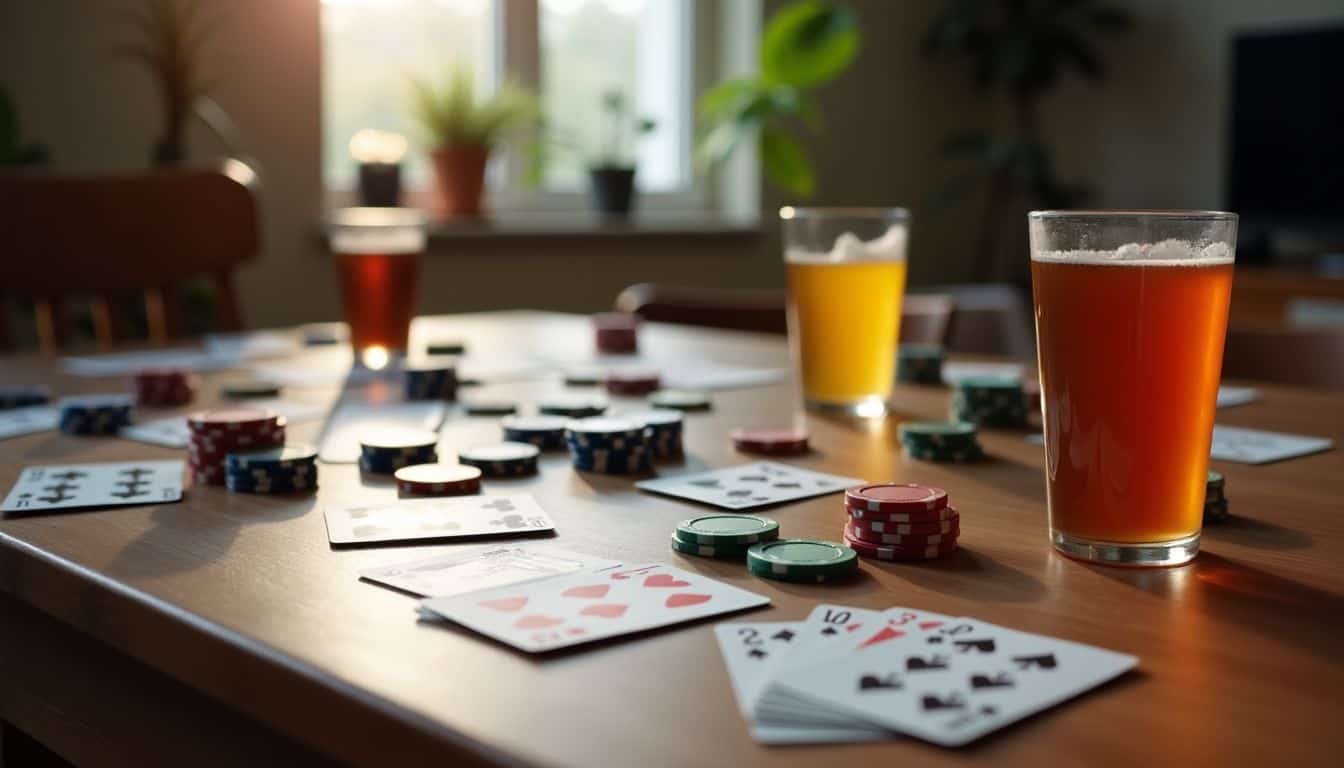
Playing poker with friends needs good manners, just like any other social game. Good poker etiquette builds trust and keeps the game fun, whether you’re playing texas hold ’em poker or other card games at your weekly poker night.
Respecting the dealer and game flow
The dealer keeps your poker game running smoothly, so give them space to work their magic. Stay quiet during dealing, and keep your cards on the table where everyone can see them. I learned this the hard way at my first texas hold’em game – talking over the dealer creates chaos and slows down the fun.
Your chips and cards need to stay in clear view, not hidden behind drinks or snacks.
Good poker flow means following basic table manners. Don’t peek at other players’ folded cards or make moves out of turn. The dealer sets the pace of the game, so let them control the action.
My poker nights got way more enjoyable once we started respecting these simple rules. The dealer’s job gets easier, and everyone has more fun when the game moves at a steady pace.
Avoiding slow play
Slow play kills the fun at poker tables faster than a bad beat. I’ve seen countless games drag on because players take too long to make simple decisions. Keep your moves quick and sharp – fold fast if your cards aren’t promising, and make your bets without endless thinking.
Your friends will thank you for keeping the hold’em action moving smoothly.
Quick play makes poker nights more exciting and lets everyone get more hands in. Put your phone away during hands, and stay focused on the game flow. Make your decisions within 30 seconds max – this keeps the energy high and prevents other players from getting frustrated.
Watch how the pros do it in the World Series of Poker (WSOP) – they know exactly when to act. Next up, let’s talk about handling those tricky moments when disputes pop up at the table.
Handling disputes amicably
Moving from slow play issues to dispute handling flows naturally in poker games. Arguments can pop up during hold’em games, even among the closest friends. A clear set of house rules stops most fights before they start.
The best approach? Stay cool and talk things through with a smile.
Friendly poker needs a peaceful vibe to stay fun. If someone raises a concern, pause the game right away. Listen to all sides without taking things personally. Most disputes come from unclear rules or misread hands.
A quick group chat usually fixes these issues. The dealer’s word should settle most basic disagreements. For tougher calls, a quick vote works wonders to keep the peace.
Strategies to Improve Your Poker Game

You’ll win more poker games by paying attention to your position at the table and reading your friends’ habits. Smart players track their chips, study their opponents’ moves, and mix up their playing style to keep everyone guessing.
Understanding position and its importance
Position in poker gives you a huge edge over other players at the table. Players in late positions, like the dealer button or cut-off, see how others act before making their own moves in hold’em games.
This power lets you make smarter choices about whether to fold, call, or raise based on what others have done.
Your spot at the table affects your expected value in every hand. Late position players can steal blinds more often and play more hands profitably. Think of it like having a sneak peek at your friends’ game plans before making your own move.
Smart players use this advantage to win more chips, even with weaker starting hands than their opponents.
Managing your chip stack
Smart position play leads right into smart chip management. Your chip stack tells a story at the poker table. The size of your stack impacts every move you make in hold’em. Players must keep track of their big blinds (BB) by dividing their total chips by the current blind level.
A healthy stack gives you room to make plays and survive bad beats.
Your chips are your lifeline at the table. Small stacks force you to play tight and look for spots to double up. Big stacks let you put pressure on others through well-timed semi-bluffs and raises.
The key is to protect your stack early in games. Make calculated risks instead of wild gambles. Stay above 20 big blinds to keep your options open. Drop below that, and you’ll need to find spots to shove all-in or fold.
Keep your stack size in mind before each hand you play.
Reading your opponents
Managing your chips leads right into the next vital skill – spotting your opponents’ moves at the poker table. Your friends might give away their hand strength through simple actions.
I’ve noticed players touch their chips more when they hold strong cards. Body language speaks volumes during hold’em games. A friend’s rapid breathing or sudden stillness can signal their confidence level.
The best poker players pay attention to betting patterns and physical signs. Your friend Sally might always bet big with strong hands, while Jane takes longer to decide with weak ones.
These patterns help you make better choices at the table. Watch for changes in how your friends handle their chips or cards. Small moves like finger tapping or chip stacking can reveal their hand strength.
Keep your own moves steady to avoid giving away your cards.
Organizing a Regular Poker Night
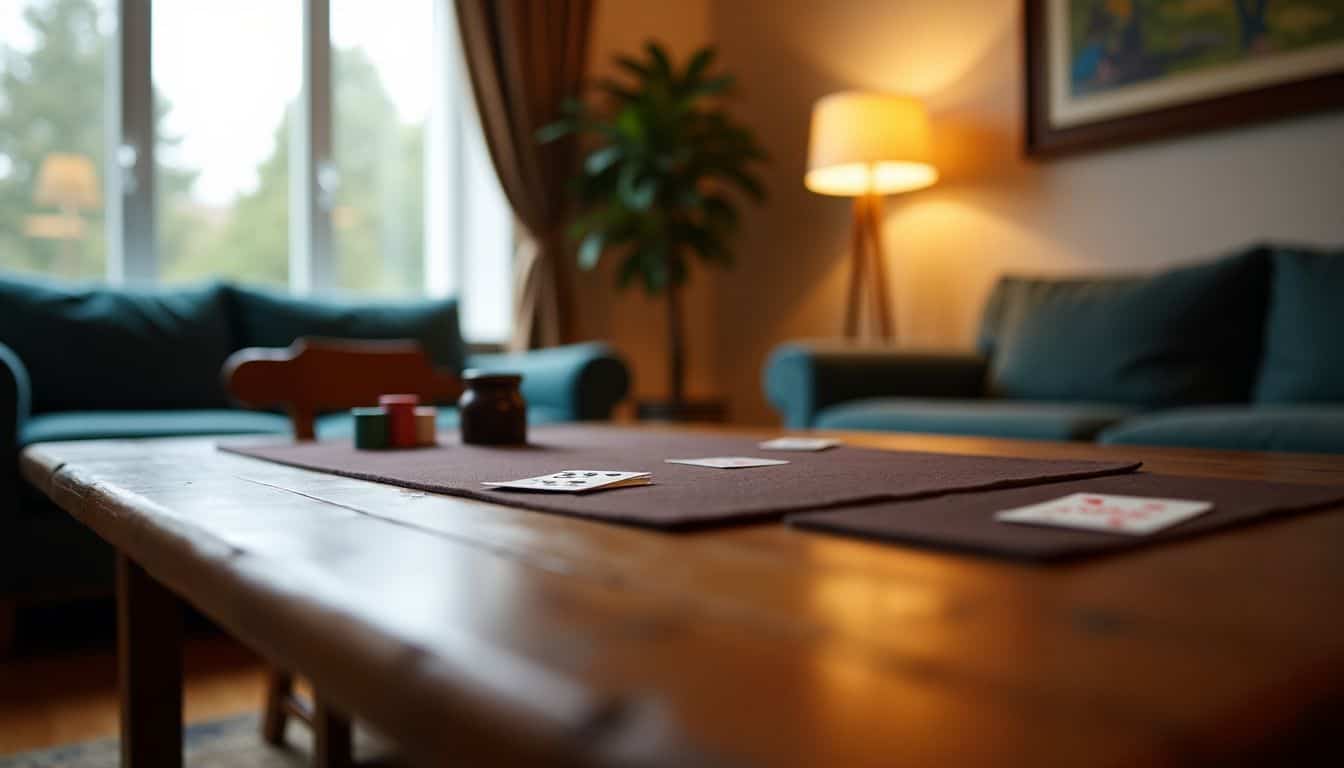
A regular poker night brings friends together for cards, laughs, and friendly competition – grab your chips and learn how to make it happen in our complete guide!
Establishing a schedule
Pick a set day each week for your poker games. Most players prefer Friday or Saturday nights after 7 PM. Your friends need time to plan ahead, so stick to your chosen day. You can host a weekly poker night that fits everyone’s schedule.
Send out e-mail invites at least three days before each game to keep attendance strong.
Your poker schedule should match your group’s lifestyle. Some friends might prefer hold’em games during lunch breaks, while others love late-night sessions. Make the timing work for most players in your group.
Missing players can hurt the fun, so pick times when most friends can join regularly. Keep track of who shows up each week to spot scheduling problems early.
Rotating hosting duties
Taking turns to host poker nights creates a fair system for everyone. Each friend gets a chance to play hold’em in their own space, adding variety to the game atmosphere. I love how my poker group rotates homes every week – it keeps the experience fresh and exciting.
Some hosts prefer casual setups with snacks on the coffee table, while others go all out with a proper poker table setup.
Sharing host duties spreads out the work and costs among friends. No single person bears the burden of cleaning up or providing refreshments every time. My friend Sarah hosts amazing game nights with her signature nachos, while Mike’s basement setup feels like a mini casino gaming room.
The rotation system helps maintain long-term poker nights because everyone stays motivated to keep the tradition going. Each host brings their own flair to poker night, from music choices to seating arrangements.
Keeping the game engaging
A point system brings life to your poker night. Mix up classic Texas Hold’em with open-faced Chinese poker to keep players excited. Create mini-challenges, like earning bonus points for winning with specific hands.
Small prizes or a trophy for the night’s champion adds extra fun to the game.
Rotate dealers every few hands to keep everyone involved in the action. Set up quick breaks for snacks and chats to maintain energy levels. Music in the background creates a relaxed vibe.
Players love hold’em tournaments with increasing blinds – it adds pressure and excitement as the night goes on. The rake-free environment among friends makes the game more enjoyable than playing at casinos or online poker rooms.
People Also Ask
What’s the easiest way to start playing poker with friends?
Start with Texas Hold’em, it’s simpler than Badugi or Black Jack. You can find free apps on Google Play or MacOS to practice. Just grab some chips, cards, and buddies who want to learn.
How do I know when to fold in poker?
Folding is key to smart poker play. If your cards look weak or others bet big, it’s often smart to fold. Think of it like leaving a party early – sometimes it’s better to save your chips for later hands.
What’s different between poker and other casino games?
Unlike slot machines or regular slots, poker needs skill and strategy. In poker, you play against friends, not the house. Each game type (Hold’em, Badugi, Black Jack) has its own rules and tricks.
What basic supplies do I need for a poker night?
You’ll need playing cards, poker chips, and a flat surface. Skip fancy gadgets – even without a proper poker table, you can play on any kitchen table. Many folks start with free poker apps on Google Play or macOS to learn the basics.
References
https://www.poker.org/latest-news/playing-poker-with-friends-a-complete-guide-aC7wp0X5EgF4/
https://www.pokernews.com/strategy/online-poker-with-friends-36910.htm
https://www.artofmanliness.com/skills/how-to/how-to-start-and-host-a-regular-poker-night/ (2015-08-18)
https://www.pokerprofessor.com/learn-poker/how-to-play-omaha-poker
https://www.pokerlistings.com/poker-rules/omaha-poker
https://poker.betmgm.com/en/blog/poker-guides/interesting-poker-house-rules-for-beginners/ (2021-10-19)
https://www.scribd.com/document/655720448/Understanding-Poker-Hand-Rankings-A-Comprehensive-Guide
https://www.pokernews.com/poker-rules/
https://www.cardschat.com/poker/strategy/poker-starting-hands/
https://www.pokerlistings.com/poker-guides/how-to-play-poker (2024-09-24)
https://www.poker.org/poker-strategy/poker-for-beginners/how-to-play-poker-online-with-friends-a3FzE9y2Pza2/ (2021-04-16)
https://www.corey.co/blog/poker
https://www.blackrain79.com/2021/09/how-to-beat-your-friends-at-poker.html
https://thelodgepokerclub.com/poker-etiquette-101-the-10-unwritten-rules-to-follow/
https://www.artofmanliness.com/living/games-tricks/6-ways-to-avoid-looking-like-a-newb-when-playing-poker/ (2015-05-11)
https://www.pokernews.com/strategy/10-hold-em-tips-08-25417.htm (2024-07-23)
https://www.pokerology.com/lessons/chip-stack-management/
https://collegeinsider.com/beginners-guide-to-playing-poker-rules-and-strategies
